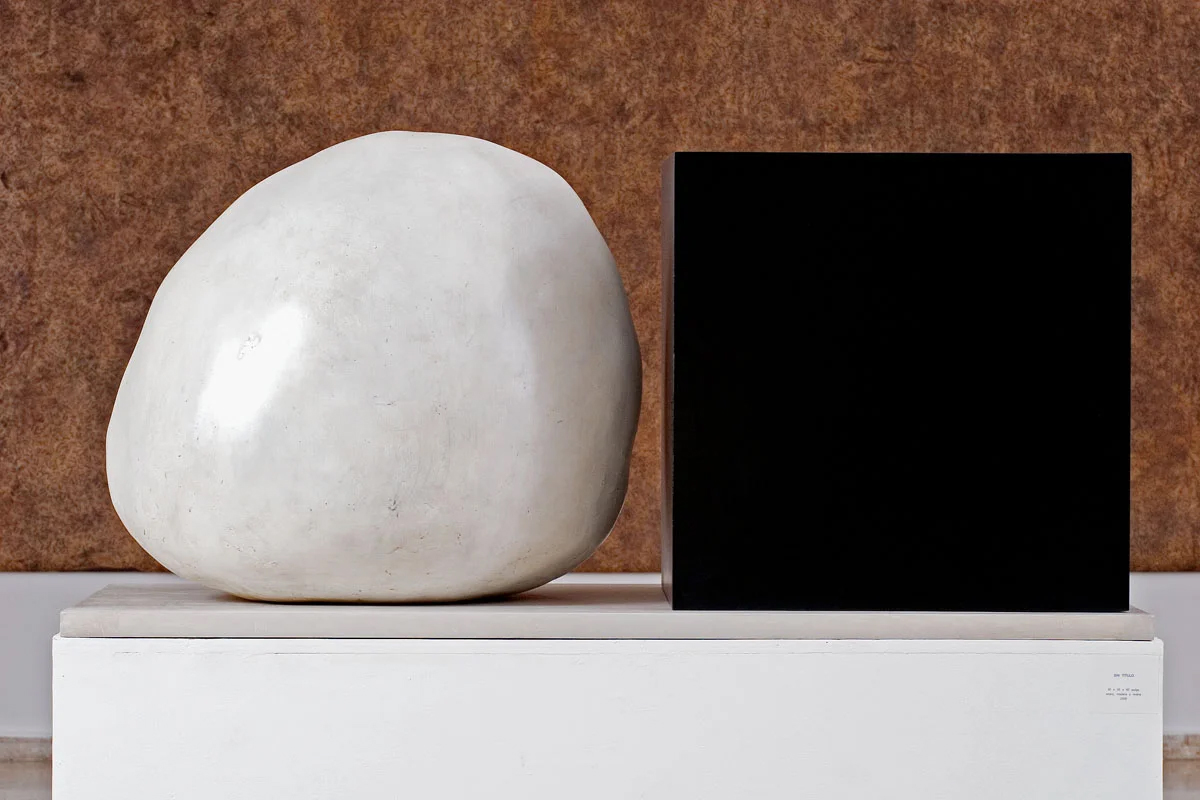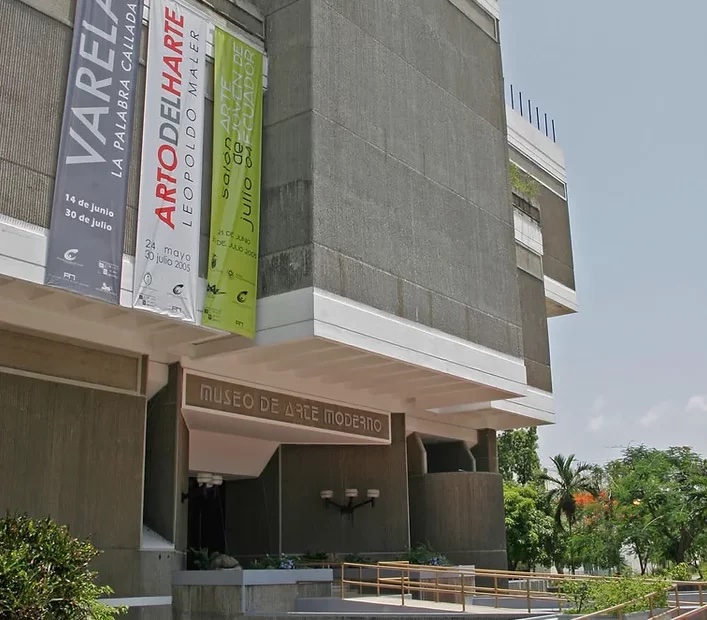Uruguayan artist Fernando Varela has lived in Santo Domingo, Dominican Republic, since 1975. In the Tropics, which is to say, on the indeterminate border between the Northern and Southern Hemispheres. And from that place, he witnesses the suture of the two hemispheres.
Unlike what Uruguay offered him, Varela found in the Dominican Republic a vital reservoir of pre-Columbian and colonial imagery (the latter a product of the syncretism between the Hispanic and pre-Hispanic imaginaries). However, Fernando Varela's work, given its transcultural circumstances, prolongs the tension that Torres García exemplified with the upside-down map between the Northern and Southern Hemispheres.
Furthermore, over these thirty years, formal elements can be discerned in his work that subliminally connect him with the painting tradition of the Río de la Plata, in particular, once again, with Torres García, and especially with the reconciliation between the universal and the Latin American. The fact that he lacked the precedent of his own great pre-Columbian cultures here enabled the Uruguayan master to achieve a synthesis with a universalist vision in Constructive Universalism, through which the cells of the neoplastic structures of his Constructivist paintings were inhabited with symbols from the universal heritage, beyond particular time and space.
-either-
DURING THE LAST DECADE, Varela produced incessantly and generally in series. Around 1997, he released Hombre, Mujer, a collection of paintings and sculptures that address spiritual and theological themes. This was followed by La magia del miedo (The Magic of Fear), from 1999, which included paintings, sculptures, and installations, including Réquiem, a cross composed of seven squares covered in letters. Amid the magma of pictorial matter in the paintings of Suite Satie (2001), the artist incorporated embossed letters, pentagrams, and informal images. Later, with Palabras de Vida (Words of Life)—exhibited in a group show of three Dominican artists, El curador curado (The Curator Curated)—he exhibited an X-ray of the brain, the seat of the conceptual world, also traversed by letters. From 2003 is the series Laislaaisla, one of whose paintings presents the island (Cuba) seen from above, with a cosmological vision.
In most of his paintings, the use of a low, Uruguayan palette predominates, as does a composition that appeals to the golden ratio, both preached by Torres García.
Varela apparently drew nourishment from the power of the tropics, but beneath it all, a connection with his past can be detected, like a stubborn will to preserve his native identity; thus, he proposes a formal compromise of extremes never suspected in the repressed modernist era.
-either-
Varela's visual language, like that practiced by most of his generation around the world, can be characterized by a highly free gestalt structuring. The images and symbols that emerge from this undifferentiated pictorial matrix pursue formal harmonization.
This becomes evident if we analyze one of the elements that draw attention in his iconography: the notable presence of the heart, which in many of his works emerges, with an unusual emotional impulse, from the material, formless, abstract language of his painting, taking on veristic features.
It is likely that Fernando Varela came up with this icon based on Frida Kahlo's use of the heart in her emblematic work Las dos Fridas (1939) with its two interconnected hearts, and it may be very significant in expressing Varela's transcultural circumstance, which reveals from an existential point of view that unresolved and unstable tension of mestizaje, of the dichotomy between the Creole and the European, which makes the two hearts in Frida's portraits a construct parallel to Torres' inverted map.
These paintings also feature attributes of the pre-Hispanic heart, inspired by Aztec sacrificial rituals and their connection to the ebb and flow of the cosmos, which was used to quench the thirst of Huitzilopochtli, patron saint of dead warriors transformed into hummingbirds. A painting by Varela from the Laislaaisla series (2003) displays a heart at the center of the composition, from whose veins emerges a spiral populated by thorns. Here, the visual extreme of organicity and its (opposite) crystallized mineral form are exemplarily united. The artist introduces the cosmic dimension almost explicitly: the circulation of blood becomes the trajectory of stars, orbits are ultimately translated into the organic, and he also highlights the resulting human pain (represented by the thorns). The heart is valued as an affective tropical Copernican center.
Varela also knows that, since the 16th century, the heart ceased to be a symbol of unity with natural forces and the powers of the gods and became an emotional, even sentimental, Baroque symbol of penitence and suffering. Thus, it appears broken and bleeding in Hearts and Thorns I and Hearts and Thorns II, both from 1997. De Profundis (1997) is a heart-shaped sculpture (tied by a rope), more veristic than the rest of his output. By superimposing the meanings attributed to the image of the heart by Christianity with the violent death drive of pre-Hispanic rituals, the artist manages to convey a perfectly syncretic image of the heart. Perpetuating this cosmological syncretism, in the diptych Genesis (1997), on the left panel of which, on a black background, he paints a red heart in the center with the Hebrew name of God (written in Latin characters), perhaps as the prime mover in the creation of the world, now from an Old Testament perspective. Paradoxically, in the era of transplants, in Varela's work this vital muscle regained its emotional charge.
It is only with modern art and its emblematic libidinous withdrawal from reality that we arrive at the exemplary Torresgarcian sign of the heart as a structural symbol of emotionality in all its multiple dimensions and complexity, counterbalancing reason, on the one hand, and the physical world and action, on the other. But Varela's work moves away from this classicist balance of these three factors in the same way that it moves away from the repressive abstract gestalt order of painting.
-either-
ONCE AGAIN, archaic revisionism rears its head in Adam and Eve, 1997. Eve is accompanied by thorns, while Adam is accompanied by a shield and a sheaf of leaves, overprinted with pages from the Old Testament, in Hebrew characters, perhaps corresponding to the biblical story of Adam. Adam and Eve refers to the Aborigines (while Torres García's Adam and Eve, 1927, refers to Africa).
Another painting in the series Laislaaisla (2003) seems to allude to Leonardo's Vitruvian Man, floating in the middle of the sea surrounded by four continents, in the four corners of the painting. The latent contents of these paintings become manifest: above all, the allusion to the maternal connotations of the waters surrounding the island: the microcosm (Cuba, the Dominican Republic, Uruguay), the macrocosm (the world?). A feeling of being lost in the undifferentiated ocean... in the Caribbean Sea?
In another, the shark fins (perhaps spines) circling the island reinforce the fear of being devoured—by time? Or by oblivion? Contrasting these fears are the silhouettes of human beings, asserting individuality, who confront undifferentiated figures repeated in several of his paintings, in profile, in the manner of Ernst Trova's sculptures, with a hieratic, frontal Egyptian air. A tropical Osiris? (The cult of the Black Virgin as an extension of the cult of Isis has its mixed devotion in America.)
In another painting from the same series, the human figure appears among thorns, surrounded by what could be the outline of a heart. It's not necessary to evoke José Martí's eclogue: "If a thorn wounds me..."
-either-
The titles of his works appeal to spiritual expressions (De Profundis, Genesis, Nemesis, A-dios to Beuys); they employ linguistic play (Laislaaisla, Suite Satie); they also often serve as clues from which to begin their approach. Those in the Suite Satie series (2001), for example, correspond to compositions by Erik Satie (Gymnopédies, Gnossiennes), and remind us of the connections between Varela's work and music. It is striking that one of the paintings in the Man, Woman series (1997) depicts the human figures as forming a keyboard.
In Tres rezos augúricos y otros cantares de la liturgia negra (Three Augur Prayers and Other Songs of the Black Liturgy), Uruguayan musicologist Alberto Soriano offers a folkloric exegesis of themes of African origin, common to the Río de la Plata, Brazil, and the Caribbean: black slaves (do not Fernando Varela's human figures perhaps appear to be black slaves, as seen in many of Pedro Figari's engravings or paintings: the gramillero (gramiller), the escobillero (brush-maker), and Mamá vieja (Old Mother), from the Montevideo Carnival?). This suggests a coincidence between Varela and the archaic regression of the first Figari, that of the Troglodytes, since both artists share a concern for the American land and for the same need to return to their origins.
-either-
In Varela's work, matter is tactile before it becomes visual: even when he incorporates letters, he presents them in relief. But the letters, the words, the phrases the artist establishes also have semantic value.
The year 2003 marks a turning point in Varela's work. His latest series, The Silent Word, is emptied of any image other than letters, letters in high relief in the paintings and in bas-relief in the sculptures. Whereas before he incorporated letters and words in counterpoint to his images—sometimes contributing to anchoring the meaning of his paintings—from now on, the entire surface of the canvas is invaded by myriads of letters, by the repetition of letters, intimately linked to their legibility. But there, meaning is obscured by their endless repetitions, alterations, and concentrations. The artist invites us to read illegible texts. Undecidable.
Varela emphasizes the materiality of words and letters, working on the continuous variation of connections through the endless shifting of possible stabilizations, insistently repeating separations and ruptures. Musical lexicon? However, in the silence of the painting, other readings will appear, barely glimpsed, guessed, that relate to aesthetics, magic, mysticism, and ethics. For his The Silent Word Speaks. The challenge is to hear it, to read it, from its murmurs and whispers.

